Communication on Tristan da Cunha
Issue date: 29th August 2025
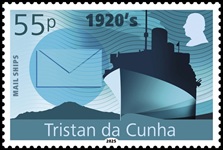 |
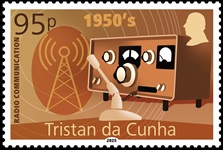 |
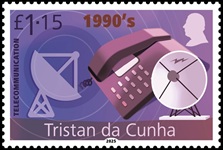 |
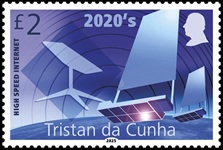 |
| Mint Stamps (55p, 95p, £1.15, £2.00) and First Day Cover | Shop > |
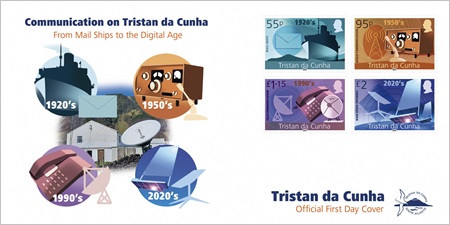
This set of commemorative stamps from the Tristan da Cunha Post Office chronicles the remarkable evolution of communication on the world's most remote inhabited island. These four stamps capture a century of progress - from handwritten letters delivered by passing ships to today's high-speed satellite internet.
This stamp issue is more than a visual timeline - it is a tribute to Tristan da Cunha's enduring spirit, adaptability, and determination to stay connected despite extreme remoteness. Each stamp captures a step forward in the island's efforts to bridge the distance and keep its voice heard in the world.
Description of the Stamps
55p - Mail Ships - 1920s
In the early 20th century, Tristan's only link to the outside world came through mail carried by passing ships - often infrequent, weather-dependent, and unpredictable. These visits might occur just once a year, and were the sole means for exchanging letters and vital goods.
There was no formal postal system at the time, and messages were often delayed by months or even years. News from abroad arrived long after events had occurred, and day-to-day life remained largely cut off from the rest of the world. Yet for Tristan's close-knit community, these mail ships were a lifeline.
The 55p stamp captures this early era of long-distance connection, with a stylised depiction of a mail ship approaching Tristan's rugged coastline - the beginning of formal communications with the wider world.
95p - Radio Communication - 1950s
Although radio equipment was first installed on the Tristan in the 1930s, it proved underpowered and unreliable, and the radios of the naval station set up on Tristan during World War II were temporary and for military use only.
A major breakthrough came in the 1950s with the permanent introduction of radio communications. The island's first radio station was established in 1950, enabling Tristan to maintain scheduled contact with South Africa and the United Kingdom, and to communicate with passing ships.
Radio brought timely news broadcasts and an essential means of coordination during emergencies. This technology proved especially critical during the 1961 volcanic eruption, when the islanders were evacuated to the UK.
While still dependent on scheduled operating hours and trained personnel, radio was a game-changer for safety and connection. The 95p stamp honours this era with imagery of vintage equipment, symbolising a new voice for Tristan on the global stage.
£1.15 - Telecommunications - 1990s
The arrival of telephone and satellite services in the 1990s ushered in a new chapter of communication. For the first time, islanders could speak in real time with loved ones overseas.
Tristan's new satellite infrastructure, including landlines and satellite dishes, made it possible to connect the island to international networks. The impact was profound: families stayed in touch more easily, emergency services improved, and a modern sense of global belonging began to emerge.
However, this new connectivity came with challenges. Equipment was expensive to install and maintain, and vulnerable to Tristan's severe weather, which often disrupted service.
The £1.15 stamp depicts a traditional desk telephone alongside a satellite dish - symbols of Tristan's leap into modern telecommunications.
£2.00 - High-Speed Internet - 2020s
The most transformative step yet came in the 2020s with the arrival of high-speed internet. Though early internet access via satellite existed, it was slow, costly, and unreliable. That changed dramatically with the introduction of Starlink, SpaceX's low-Earth orbit satellite internet service.
Starlink brought unprecedented broadband access to even the most remote corners of the island. Islanders could now participate in video calls, access global news in real time, and use cloud services, e-commerce, and streaming media just like anyone else in the world.
The £2.00 stamp features sleek satellite terminals and a stylised digital grid, illustrating the island's emergence into the digital age.
Impact of Starlink on the Tristan da Cunha Community
High-speed internet has transformed daily life on Tristan da Cunha. Telemedicine services are now accessible, enabling faster diagnosis and treatment. Online education has broadened learning opportunities, especially for young people. Businesses can reach global markets, and tourism promotion has become more viable.
More importantly, this new connectivity allows Tristan residents to preserve their culture while participating in a global conversation. Social media and messaging platforms have bridged personal and cultural distances that once seemed insurmountable.
FDC - The FDC has vignettes from all four stamp designs surrounding an image of the settlement's communications hub.
Technical Specifications
| Designer: | Andrew Robinson | Printer: | Cartor Security Printing |
| Stamp size: | 42 x 28mm | Perforation: | 13¼ x 13½ per 2cms |
| Process: | Lithography | Sheet Layout: | 10 |
| Production Co-ordination: | Creative Direction (Worldwide) Ltd | ||
